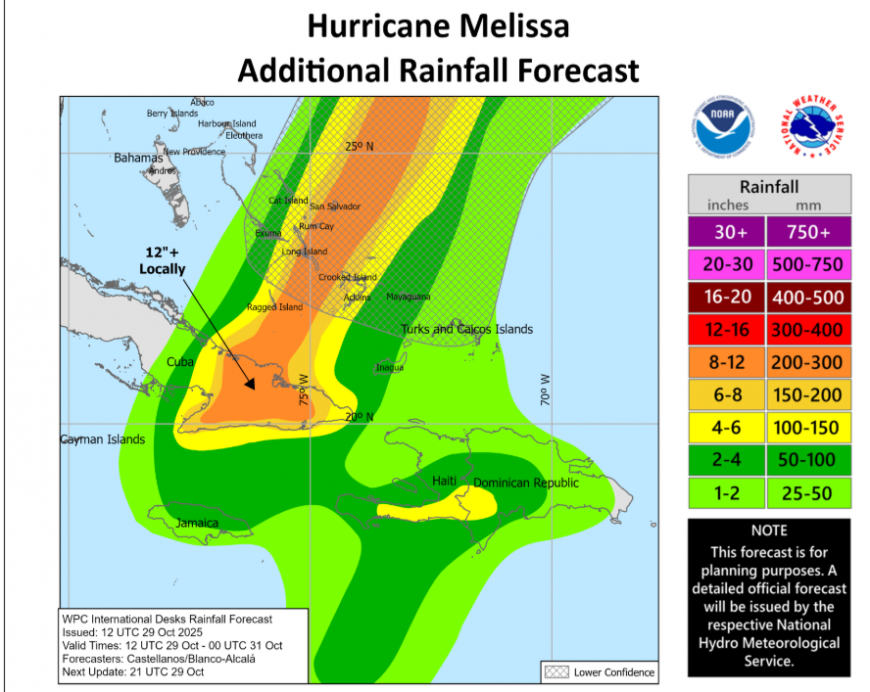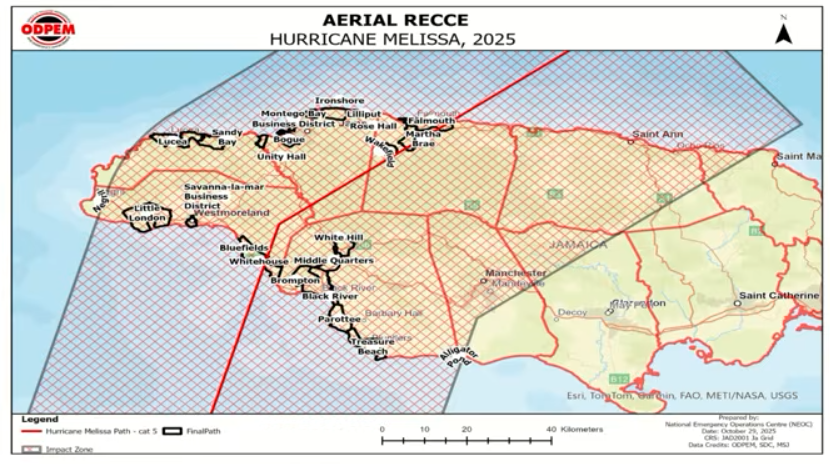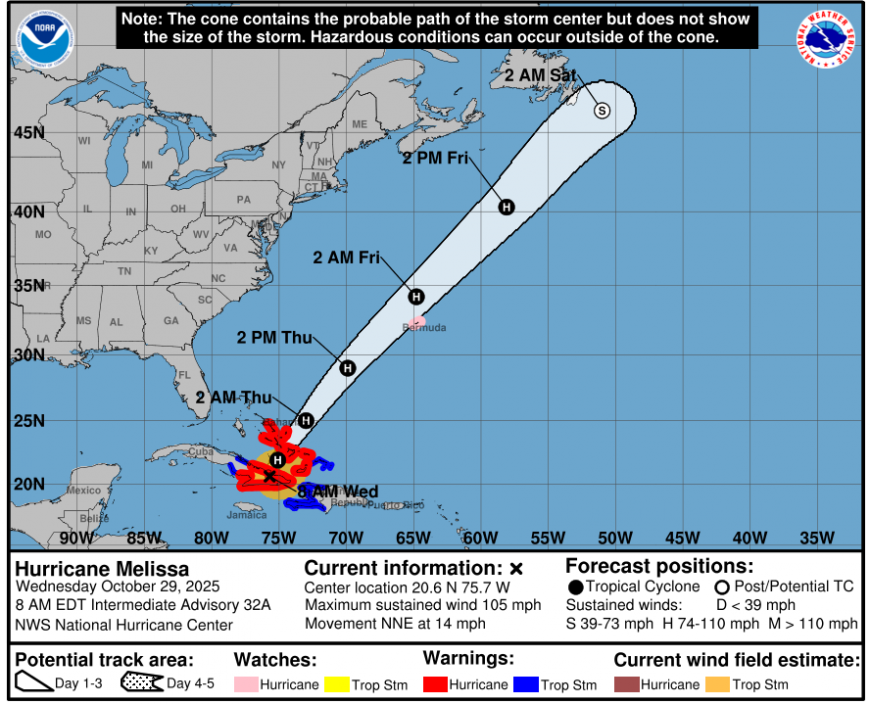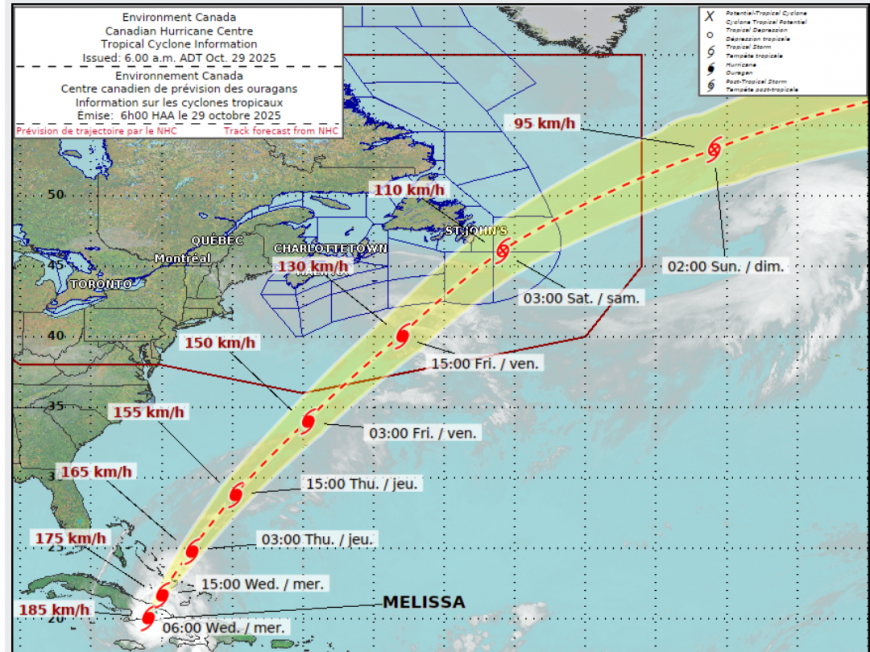
In Jamaica, 6,000 people have been displaced, with 800 shelters activated nationwide in Hurricane Melissa. In Cuba, at least 750,000 people were evacuated. Even as Hurricane clears away from Cuba, local warnings continue in Jamaica for the risk of flash flooding and landslides.

Even if the warnings helped people survive the actual event, they will now be facing a lack of shelter, lack of food and water, the risk of disease and disruption to society, livelihoods, safety, education and the risk of poverty and poor health greatly increased.
Amongst the chaos, the Jamaican Information Service (JIS) press briefing announced that, at least, three babies were born in the hurricane, “Melissa babies”. The Minister of Local Government, McKenzie solemnly said “It is not going to be an easy road, Jamaica” when talking about the recovery they face. In the west of the island, search and rescue continues where that is possible, although there is a lot of debris, standing water and structural damage, often without power.

ODPEM Hurricane Melissa path- cat 5 and Impact Zone
Hurricane Melissa was Jamaica’s strongest hurricane on record with a pressure of 892 hPa, sustained winds of 185mph and a provisional gust (recorded just above the ocean floor by the Hurricane Hunter aircraft) of 252 mph. If confirmed, this would be the highest gust ever recorded in a tropical system.
Cuba
Melissa made its second landfall in the province of Santiago de Cuba, on the south coast of the eastern end of Cuba, Wednesday at 0710 UTC. Estimated as a Category 3 hurricane with maximum sustained winds of 105 knots, 120 mph. Life-threatening storm surge, flash flooding and landslides with damaging hurricane winds have impacted Eastern Cuba with the outer bands reaching Haiti, the Bahamas and the Turks & Caicos. The same message of “Remain in Shelter!” was being repeated. There is mountainous terrain in eastern Cuba , which should weaken Melissa on her progress northwards.

The warnings have now ceased over Jamaica but extend over the Bahamas with tropical storm warnings for Haiti and more of Cuba before the hurricane heads northeastwards. NHC are warning on Wednesday of “Catastrophic flash flooding and landslides" for Hispanola with extensive damage and isolation of communities for Haiti. There is strong model agreement that Melissa will move close to Bermuda later on Thursday, to the west of the remote Atlantic island with heavy rainfall and hurricane conditions possible by Thursday night.
The UK Foreign, Commonwealth & Development Office advice; for Bahamas “Hurricane Melissa has developed into a major hurricane and is forecast to bring exceptional levels of rainfall and high storm surges in the coming days” and for Jamaica
“Hurricane Melissa If you are a British national in Jamaica, FCDO strongly encourages you to Register Your Presence. This will allow FCDO to share important updates…Hurricane Melissa brought exceptional levels of rainfall and strong winds to the whole of Jamaica, causing widespread disruption to services. Jamaica’s international airports are closed until further notice.”

The Canadian Hurricane Centre will be watching Melissa’s progress north as it is expected to become post-tropical offshore from Newfoundland and perhaps bringing rain to the UK by the end of the weekend.
What next for Jamaica and Cuba?
With communications disrupted, many families are worried as they can not reach other people. Authorities are assessing the damage, trying to get to the worst hit areas and the people and infrastructure that have been impacted.
The Associated Press has been reporting “Damage is extensive in parts of southern and southwestern Jamaica. Four hospitals are among the likely hundreds of damaged structures. More than half a million customers have lost power. “
People may have to remain in shelter due to the water inundation, surface water flooding from the torrential rains and downed power lines. Clean water supplies will be interrupted as well as food supplies. Before the hurricane arrived, people were advised to keep enough food and water for 2 to 3 days.
For island nations, getting aid by air is a priority. Emergency preparations began before the event with “warehouse management and prepositioning logistics assets such as mobile warehouses, generators, chainsaws and satellite-based units for connectivity.” World Food Programme. The Starlink communications have been helping since the 29th.
Since Jamaica imports much of its food, recovery will depend on how quickly supply chains can be restored.
As Jamaican authorities move towards the recovery phase, physical work continues to clear debris and help open facilities such as hospitals and the airports to allow aid to arrive, before thoughts turn to letting tourists return home after the event. Utility companies can start their recovery efforts as the All Clear has now been given after the hurricane. These efforts will focus on water, electricity and communication networks as supermarkets, pharmacies and gas stations try to re-open, firstly in the less affected areas such as in the eastern end of Jamaica. 77% of the country is without electricity, according to the JIS (Jamaican Information Service). Around 70+ water systems (out of 700) have gone stopped in the hurricane, with some additional turbidity issues, where the water is cloudy.
Sangster International Airport in Montego Bay, the busiest airport in Jamaica, will remain closed with little information available. Norman Manley International Airport, located in the capital city of Kingston, might open for relief efforts on Thursday, depending on the damage. Ian Fleming Airport may be an alternative for aid.
The capital Kingston, sustained minimal damage and power companies are working to repair this area first, with one million inhabitants, before the major works needed elsewhere. There has been significant damage to schools in western Jamaica.

Melissa ranks among the most intense hurricanes ever observed in the Atlantic basin. On Oct 28th at 15:55 UTC, a Copernicus Sentinel-2 satellite captured a vivid view of hurricane Melissa's eye just a few hours before landfall on the southern coast of Jamaica.
“High-resolution imagery from the Copernicus Sentinel-2 satellite mission plays a crucial role in crisis management. It supports rapid mapping and the coordination of relief efforts.”
More discussion about Hurricane Melissa in the Netweather community forum
Top image NASA Sport NOAA GOES EAST satellite Oct 29, 2025 - 16:09 UTC
Loading recent activity...